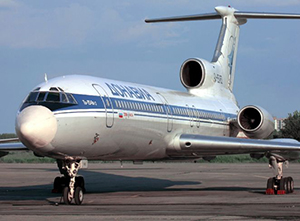Moscow, Dec 25: A Russian military plane crashed today in the Black Sea as it made its way to Syria with 92 people onboard, including Red Army Choir members heading to celebrate the New Year with troops.
Local news agencies, citing the defence ministry, said the Tu-154 plane had crashed shortly after take-off from the southern city of Adler at 5:40 am local time.
Defence ministry spokesman Igor Konashenkov told Russian news agencies that one body had been recovered six kilometres off the coast of the resort city of Sochi, as a frantic search operation continued to hunt for the missing.
"Fragments of the Tu-154 plane of the Russian defence ministry were found 1.5 kilometres from the Black Sea coast of the city of Sochi at a depth of 50 to 70 metres," the ministry said.
The plane had been on a routine flight to Russia's Hmeimim airbase in western Syria, which has been used to launch air strikes in Moscow's military campaign supporting its ally President Bashar al-Assad in the country's devastating civil war.
Among the 84 passengers of the plane were Russian servicemen as well as members of the Alexandrov Ensemble, the army's official musical group internationally known as the Red Army Choir, who were headed to Syria to participate in New Year celebrations at the airbase.
There were also eight crew members onboard, the ministry said.
Nine journalists were among the passengers, with state-run channels Pervy Kanal, NTV and Zvezda saying they each had three staff onboard the flight.
Kremlin spokesman Dmitry Peskov told news agencies that President Vladimir Putin had been informed of the situation and was being kept updated on the search operation.
"It's too early to say anything," agencies quoted Peskov as saying, adding that Putin was in constant contact with Defence Minister Sergei Shoigu.
"The president is waiting for the picture to be clear."
Konashenkov said that Deputy Defence Minister Pavel Pop
ov had flown to Adler along with a team tasked with clarifying the circumstances surrounding the crash.
Russia's Investigative Committee said a criminal probe had been launched to determine whether violations of air transportation safety had led to the crash.
Investigators are currently questioning the technical personnel responsible for preparing the plane for take-off, the committee said.
Tu-154 aircraft have been involved in a number of accidents in the past.
In April 2010 many high-ranking Polish officials, including then president Lech Kaczynski, were killed when a Tu-154 airliner went down in thick fog while approaching the Smolensk airport in western Russia.
Moscow has been conducting a bombing campaign in Syria in support of Assad since September 2015 and has taken steps to boost its presence in the country.
In October, Putin approved a law ratifying Moscow's deal with Damascus to deploy its forces in the country indefinitely, firming up Russia's long-term presence in Syria.
Russian warplanes have flown out of the Hmeimim base to conduct air strikes, and the base is also home to an S-400 air defence system.





Comments
RUSSIAN PRESEDENT PUT IN NOW REALIZING
Innocent people of Syrian children prayer will burn Russia one by one.
Trust Allha every one........ will be punish...............
Add new comment